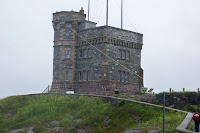July 12-14, 2011. We drove off the ferry and started towards St. John’s some 88 miles away.
We were on a two lane road, making good time when we saw a slow down ahead and sure enough we came upon two moving chicanes. Soon we got around them and the road became a divided highway.
Through out the Atlantic Provinces I have been amazed at all the beautiful inlets, coves, estuaries and lakes. There is a tremendous amount of waterfront property that any developer would sell his soul for. However, this beautiful property is not for the weak in the winter.
After setting up, having dinner and getting a good night’s rest we were off touring again.
Our first stop was in the village of Quidi Vidi which has two claims to fame, possibly the oldest house on the island and a local brewery. The brewery not only has a gift shop but they had for sale 6-packs of several of the beers they brew. I think the weight of our buss doubled when the guys came back with the beer.
In the past as today protected harbors were essential to protect the fishing boats, ships and residents. Quidi Vidi’s harbor falls into this category as you can’t see the open ocean from it’s docks.
3117P
Each province had a governor who was appointed to the position by the Prime Minister rather than elected by the people. It was usually a person who had the right political connections. We visited the grounds of Government House.
As we were walking around the grounds it started to rain so it was back on the buss and on to Signal Hill
Signal Hill is the high ground that overlooks the inlet and harbor of St. John’s. It has always been used for defense but also as an observation and communication point. It is here that in 1901, Marconi received the first wireless trans-Atlantic communication. France and England fought many battles over the location. From the inlet , the waterway narrows to about 200 feet before widening into the harbor.
The first defenses of the harbor were shores batteries on either side of “the narrows”. The French held St. John’s in1696, 1705 and 1709. The treaty of Utrecht in 1719 gave the territory to the English but peace was only temporary as the French captured St. John’s again in June of 1762. The French succeeded by attacking from the land side rather than the sea. In September of that year the English used the same tactic to essentially walk up Signal Hill surprise the defenders and take the hill for the final time. After a night of mortar bombardment into the French positions below, the French surrendered St. John’s for the final time. Today, Cabot Tower sits at the top of Signal Hill.
As we looked at the harbor we could at the city and dock area that was our next stop. We were near the point where the narrows opened into the harbor. We walked on one of the docks and looked at the fishing boats. I took a picture of a hydraulic powered reel that the fishermen used to haul in their crab traps. Snow Crabs are their primary catch. Across the water we could see the houses that are built on the hillside. They have a marvelous view of the activity in the harbor.
After the docks we went to lunch. I was sorry that I didn’t have my camera with me. The food was excellent and the presentation of the salad, main course and dessert was wonderful and worthy of a picture.
In the mid 1830’s the more than 100,000 Catholics needed to replace an old wooden chapel that could only hold a few hundred worshipers. Bishop Fleming led the effort to build a grand church and construction started and was unfinished when a then ailing bishop Fleming said the first mass. The cathedral was finished by his successor and consecrated on September 9th, 1855.
On display is the sculpture Redeemer in Death, one of three that exist today. There are 65 stained glass windows. In 1983 it was declared a National Historic Site by the Government of Canada and1955 it was given the honorary rank of “Minor Basilica”.
3188
We then went to the Motherhouse to see the sculpture of the “Veiled Virgin”. It was sculpted by Giovanni Strazza from Carrera Marble, a marble with no flaws.
3201
Our last stop for the day was the Cape Spear National historic Site. There has been a lighthouse here since 1836. During WWII, from 1941 to 1945 American and Canadian Troops were stationed here and two 10” guns at the tip of the Cape provided coastal defense for ST. John’s harbor. We had some fun poising for pictures here as it is the most easterly point in North America. There were whales’ off-shore and Jackie caught a picture of a spout. Though difficult to see, it is the white blur in the middle of the picture.
6877c
The picture album is at: http://summer2011jb.shutterfly.com/pictures/2498

































When you return, I suggest you have some of your photos enlarged and possibly framed for wall display.
ReplyDeleteI thought the one in this batch on top of the high bluff overlooking the harbor was particularly stunning.